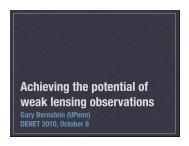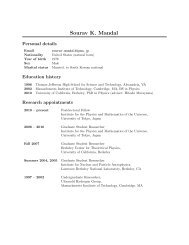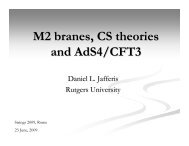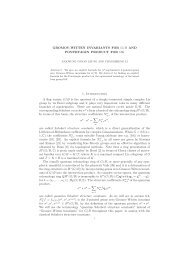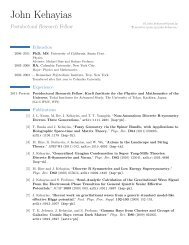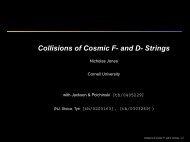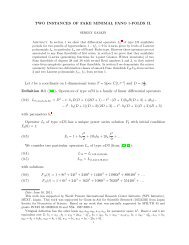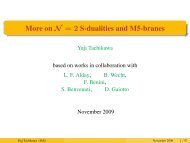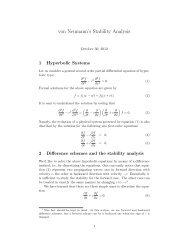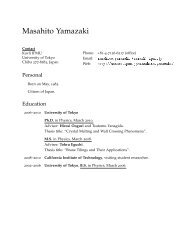STUDY SUMMARY - IPMU
STUDY SUMMARY - IPMU
STUDY SUMMARY - IPMU
You also want an ePaper? Increase the reach of your titles
YUMPU automatically turns print PDFs into web optimized ePapers that Google loves.
<strong>SUMMARY</strong> REPORT<br />
WIDE FIELD FIBER-FED OPTICAL<br />
MULTI-OBJECT SPECTROMETER (WFMOS)<br />
Figure 2.3-1: Fractional precision of various surveys. Left panel illustrates the expected<br />
fractional precision of various surveys in measuring the acoustic scale (using our own<br />
S/N formula, as discussed in the OCDD). Right panel shows the fractional precision in<br />
the growth rate (following White, Song & Percival 2008). The observed results for the<br />
2dFGRS and SDSS at low redshift are plotted as points, together with the predicted<br />
accuracy of the VIPERS VLT survey. The lines are intended to show the precision<br />
expected in redshift shells of width 0.1. In the left-hand panel, we also show (triangle<br />
points connected by dotted lines) the average precision expected from the full volume of<br />
BOSS and of our WFMOS surveys......................................................................................... 11<br />
Figure 2.4-1: A measure of the impressive data-gathering power of WFMOS in<br />
comparison to other wide field spectroscopic facilities. The ordinate represents the<br />
product of the multiplex and number of resolved spectral elements above a fixed<br />
signal/noise per unit observing time. Our team has learned much from its extensive use<br />
of the FLAMES and DEIMOS instruments, and this has been reflected in our WFMOS<br />
requirements. .............................................................................................................................. 13<br />
Figure 3.2-1: WFMOS Block Diagram ................................................................................... 19<br />
Figure 3.6-1: Schematic of Single Camera on the Prime Focus Support Strut .............. 28<br />
Figure 3.6-2: 1100 Series Camera from Spectral Instruments, Inc. ................................. 29<br />
Figure 3.6-3: Optical Layout of the Subaru Telescope and the Metrology Camera....... 29<br />
Figure 3.7-1: The WFMOS Field Element–to–Fiber Tip Coupling Efficiency .................. 30<br />
Figure 3.8-1: The proposed configuration of the WFMOS A&G System. A coherent fiber<br />
bundle reimages the focal plane onto the A&G Camera. .................................................... 31<br />
Figure 3.9-1: The Prime Focus Instrument ........................................................................... 32<br />
Figure 3.9-2: The Rotating Portion of the PFI ...................................................................... 33<br />
Figure 3.9-3: The PFI Fixed Structure ................................................................................... 33<br />
Figure 3.10-1. Positioner Bench Populated with One Module and a Single Positioner. 35<br />
Figure 3.10-2: Positioner Patrol Region Overlap. The black dashed lines indicate the<br />
patrol regions of adjacent positioners, showing there is complete coverage of the<br />
populated field of view. The distance between adjacent positioners, d, is 8 mm, while<br />
the diameter of the Patrol Region, 2R, is 9.5 mm. Blue and orange represent the two<br />
stages of the positioner motors (see text).............................................................................. 36<br />
Figure 3.10-3: Optical coupling efficiency versus distance from the center of the field of<br />
view. The plot shows the field coverage of the positioner array. Coupling includes the<br />
optical performance of the WFC and the numerical aperture of the fiber, but does not<br />
include seeing or WFC internal flexure................................................................................... 37<br />
Figure 3.10-4: The Prototype Cobra Fiber Positioner ......................................................... 38<br />
Figure 3.10-5: Rotary Squiggle Motor Motive Force Schematic........................................ 38<br />
Figure 3.10-6: Patrol Region of a single fiber positioner (top view). The two motors in<br />
each positioner have axes that are offset from one another, allowing the fiber tip to<br />
travel anywhere within the patrol region................................................................................. 39<br />
Figure 3.10-7: Positioner System Block Diagram ................................................................ 40<br />
Figure 3.10-8: Prototype Positioner Testbed. A light source illuminates a fiber optic<br />
mounted in the Cobra positioner unit under test. A CCD camera accurately measures<br />
the position of the fiber tip......................................................................................................... 42<br />
Figure 3.11-1: Schematic of the fiber system from the positioners to the spectrograph.<br />
Pictures of key hardware from risk-reduction activities are also shown............................ 43<br />
Figure 3.11-2: Fiber Throughput and the Contribution from Various Components........ 44<br />
Figure 3.12-1: The optical design of a single WFMOS spectrograph, shown here as<br />
configured for the GAHR survey. The diameters of the major optical elements are<br />
shown in millimeters. ................................................................................................................. 48<br />
Figure 3.12-2: CAD model of one of the three identical spectrographs, shown here as<br />
configured for the GAHR survey. The table is approximately 5 m × 3 m.......................... 48<br />
iv



